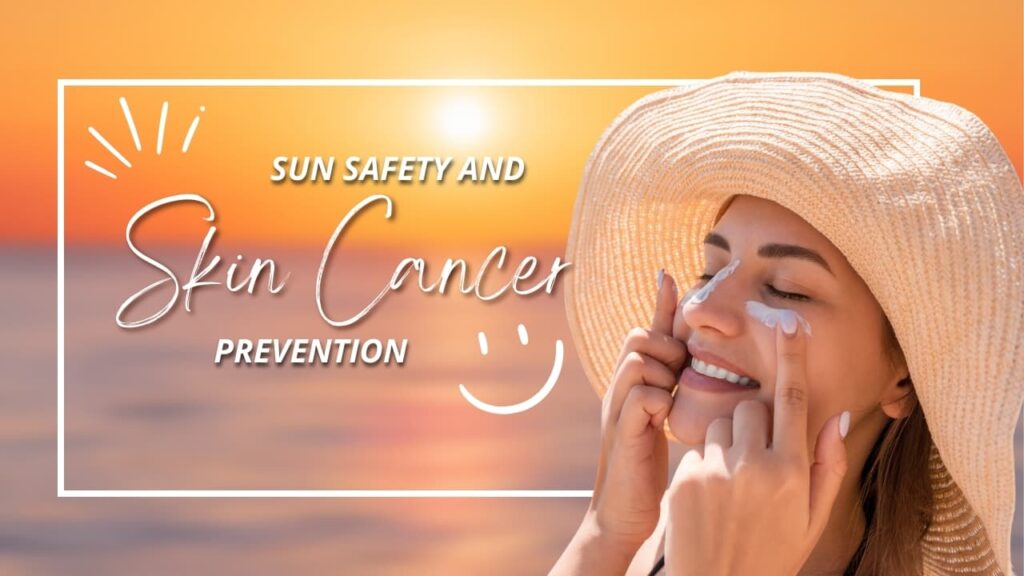Last updated on July 2nd, 2025 at 05:47 pm
 The warm embrace of the sun often beckons us outdoors, enticing us with its golden rays and promises of vitamin D. However, amidst this allure lies a potential danger: the risk of skin cancer. As summer approaches and outdoor activities become more appealing, it’s crucial to prioritize sun safety and educate ourselves on effective prevention measures.
The warm embrace of the sun often beckons us outdoors, enticing us with its golden rays and promises of vitamin D. However, amidst this allure lies a potential danger: the risk of skin cancer. As summer approaches and outdoor activities become more appealing, it’s crucial to prioritize sun safety and educate ourselves on effective prevention measures.
Understanding Sun Exposure
Before delving into prevention strategies, it’s essential to understand the dynamics of sun exposure. The sun emits ultraviolet (UV) radiation, consisting of UVA, UVB, and UVC rays. While UVC is largely absorbed by the ozone layer and doesn’t reach the Earth’s surface, UVA and UVB rays penetrate the atmosphere and can cause significant damage to the skin.
UVA rays penetrate deep into the skin, contributing to premature aging, wrinkles, and suppression of the immune system. UVB rays primarily affect the outer layers of the skin, leading to sunburns and increasing the risk of skin cancer, including melanoma, the most deadly form of skin cancer.
Skin Cancer: Types and Risk Factors
Skin cancer occurs when skin cells undergo abnormal growth, typically triggered by UV radiation exposure. The three primary types of skin cancer are basal cell carcinoma (BCC), squamous cell carcinoma (SCC), and melanoma.
Basal cell carcinoma and squamous cell carcinoma are more common and tend to develop on sun-exposed areas such as the face, ears, neck, and scalp. Although they are generally less aggressive than melanoma, early detection and treatment are crucial to prevent disfigurement and potential spread.
Melanoma, while less common, is the most lethal form of skin cancer, with the potential to metastasize to other organs if not detected and treated early. It often manifests as an irregularly shaped mole with uneven borders, varying colors, and a diameter larger than a pencil eraser. Understanding the warning signs of melanoma through the ABCDE mnemonic (Asymmetry, Border irregularity, Color variation, Diameter larger than 6mm, Evolution or change in size, shape, or color) is vital for early detection.
Risk factors for skin cancer include:
- Prolonged exposure to UV radiation, whether from the sun or tanning beds.
- Fair skin, light hair, and blue or green eyes, which are less equipped to handle UV exposure.
- Family history of skin cancer.
- Personal history of sunburns or excessive UV exposure.
- Weakened immune system due to medical conditions or medications.

Skin Cancer Prevention
Skin cancer prevention is a vital aspect of maintaining skin health and reducing the risk of developing this potentially life-threatening condition. Skin cancer, including melanoma, basal cell carcinoma, and squamous cell carcinoma, is primarily caused by exposure to ultraviolet (UV) radiation from the sun and artificial sources like tanning beds. However, with the right preventive measures, you can significantly reduce your risk of developing skin cancer.
Sun Safety Practices
Protecting yourself from the harmful effects of UV radiation is paramount for skin cancer prevention. Incorporating sun safety practices into your daily routine can significantly reduce your risk of skin cancer and premature aging. Here are some essential tips:
1. Seek Shade
Limit direct sun exposure, especially during peak hours between 10 a.m. and 4 p.m. When outdoors, find shelter under umbrellas, trees, or awnings to stay in the shade.
2. Wear Protective Clothing
Covering up with lightweight, long-sleeved shirts, pants, and wide-brimmed hats provides an additional barrier against UV radiation. Seek out clothing that has UPF (Ultraviolet Protection Factor) ratings for enhanced sun protection.
3. Apply Broad-Spectrum Sunscreen
Choose a broad-spectrum sunscreen with SPF (Sun Protection Factor) 30 or higher to protect against both UVA and UVB rays. Apply sunscreen generously to all exposed skin, including the face, neck, ears, and hands, at least 15 minutes before sun exposure. Reapply every two hours, or more often if you’re swimming or sweating.
4. Protect Your Eyes
Wear sunglasses that block 100% of UVA and UVB rays to protect your eyes from sun damage and reduce the risk of cataracts and macular degeneration.

5. Avoid Tanning Beds
Tanning beds emit concentrated UV radiation, increasing the risk of skin cancer and premature aging. Opt for safer alternatives such as self-tanning lotions or spray tans for a sun-kissed glow.
6. Perform Regular Skin Checks
Conduct monthly self-examinations to monitor for any changes in moles, freckles, or skin growths. Use the ABCDE mnemonic (Asymmetry, Border irregularity, Color variation, Diameter larger than 6mm, Evolution or change in size, shape, or color) to identify suspicious lesions. If you notice any concerning changes or new growths, consult a dermatologist promptly for evaluation.
7. Stay Hydrated
Proper hydration is essential for maintaining skin health and resilience. Drink plenty of water to keep your skin hydrated, which can help minimize the risk of sun damage and promote faster recovery from sunburns.
8. Be Mindful of Medications
Some medications, such as certain antibiotics, diuretics, and acne treatments, can increase sensitivity to sunlight and heighten the risk of sunburn. Consult your healthcare provider or pharmacist for guidance on sun safety while taking these medications.
9. Healthy Lifestyle Choices
Adopting a healthy lifestyle can also contribute to skin cancer prevention. Consuming a well-rounded diet filled with fruits, vegetables, and antioxidants can enhance overall skin health. Additionally, avoiding tobacco products and excessive alcohol consumption can help reduce the risk of certain types of skin cancer.
10. Regular Skin Cancer Screenings
Routine skin cancer screenings by a dermatologist are crucial for early detection and treatment. Dermatologists can perform thorough skin examinations to identify suspicious lesions and recommend further evaluation or biopsy if necessary. Individuals with a family history of skin cancer or other risk factors may benefit from more frequent screenings.
Skin Cancer Screening and Early Detection
In addition to practicing sun safety, regular skin cancer screenings are essential for early detection and treatment. Dermatologists can perform thorough skin examinations to identify suspicious lesions and recommend further evaluation or biopsy if necessary. Individuals with a family history of skin cancer or other risk factors may benefit from more frequent screenings.
For individuals who experience allergic reactions or skin sensitivity due to sun exposure, dermatologists may recommend antihistamines or anti-inflammatory treatments. In some cases, medications like Eqoq Tablet 10’s can help manage symptoms such as redness, itching, and rashes caused by UV-triggered skin responses.
Conclusion:
Prioritizing sun safety is crucial for protecting your skin from the harmful effects of UV radiation and reducing the risk of skin cancer. By incorporating sun-safe practices into your daily routine and staying vigilant about changes in your skin, you can enjoy the outdoors while safeguarding your skin health for years to come. Remember, prevention is key, and proactive measures today can lead to a lifetime of sun-safe enjoyment.
FAQs on Sun Safety and Skin Cancer Prevention
Q1. Why is sun protection important?
Answer: Sun protection is crucial because exposure to ultraviolet (UV) radiation from the sun can damage the skin, leading to sunburns, premature aging, and an increased risk of skin cancer. By practicing sun safety measures such as wearing sunscreen, seeking shade, and wearing protective clothing, you can significantly reduce your risk of sun-related skin damage and maintain healthier skin in the long run.
Q2. How often should I apply sunscreen?
Answer: It’s recommended to apply sunscreen generously to all exposed skin, including the face, neck, ears, and hands, at least 15 minutes before sun exposure. Reapply sunscreen every two hours or more frequently if swimming or sweating, as water and sweat can reduce its effectiveness. Additionally, reapply sunscreen after toweling off or engaging in activities that may remove the sunscreen from your skin.
Q3. What are the warning signs of skin cancer?
Answer: The warning signs of skin cancer can vary depending on the type of cancer, but common signs include changes in the size, shape, color, or texture of moles, freckles, or skin lesions. It’s essential to be vigilant for any new growths or lesions that don’t heal, as well as existing moles or spots that exhibit characteristics such as asymmetry, irregular borders, uneven coloring, or enlargement. If you notice any concerning changes in your skin, consult a dermatologist for evaluation.
Q4. Are tanning beds safe?
Answer: No, tanning beds are not safe. Tanning beds emit concentrated ultraviolet (UV) radiation, which can damage the skin and increase the risk of skin cancer, including melanoma, the most deadly form of skin cancer. Using tanning beds also contributes to premature aging, including wrinkles, age spots, and loss of skin elasticity. It’s best to avoid tanning beds altogether and opt for safer alternatives such as sunless tanning products for a sun-kissed glow without the risk of UV exposure.